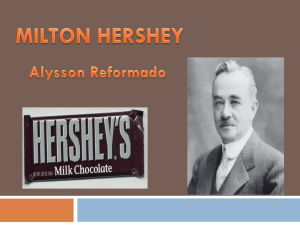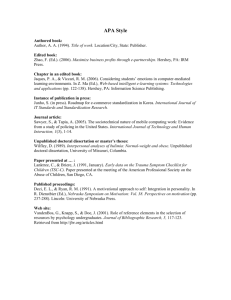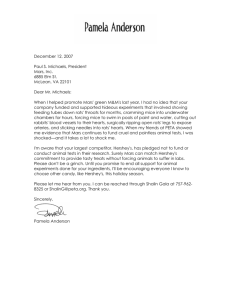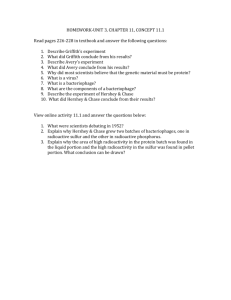Document
advertisement
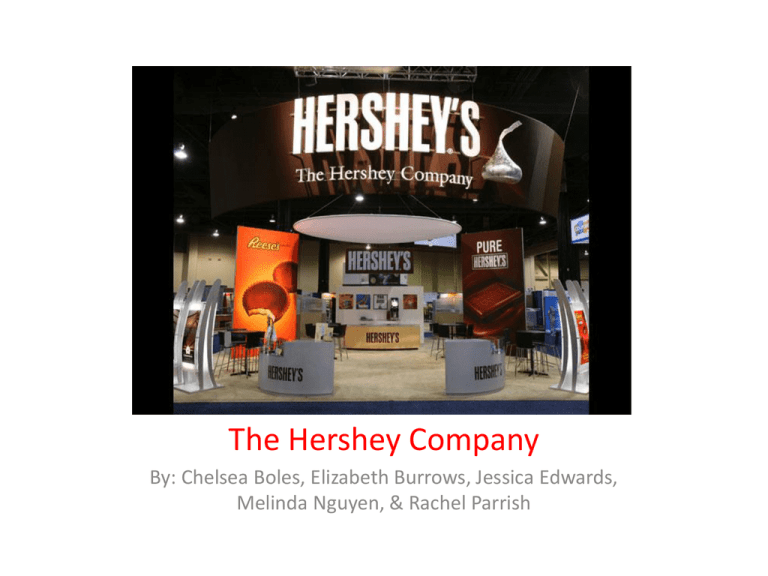
The Hershey Company
By: Chelsea Boles, Elizabeth Burrows, Jessica Edwards,
Melinda Nguyen, & Rachel Parrish
• The Hershey Company is the leading North American
manufacturer of quality chocolate and candies.
• Future Vision: To expand into more categories beyond
candies, finding new ways to bring goodness to people
everywhere.
Business Level Strategy
Best-Cost Provider
More Value for Money
Satisfy Expectations
Resources & Capabilities
Value Conscious Buyers
Target Market & Demographics
• Target Market: North America
% of Consumption
18.0%
16.0%
14.0%
12.0%
10.0%
8.0%
6.0%
4.0%
2.0%
0.0%
Household Income
16.0%
14.0%
12.0%
10.0%
8.0%
6.0%
4.0%
2.0%
0.0%
Age Age Age Age Age Age
18-24 25-34 35-44 45-54 55-64 65+
% of Consumption
External Analysis: 5 Competitive Forces
Overall – Moderately high
Substitutes
Moderate
Suppliers
Rivals
Moderately
High
Moderately
High
New
Entrants
Weak
Buyers
Moderate
External Analysis: Strategic Group Map
Financial Analysis
Company Profitability
Gross Profit Ratio
0.6
0.5
0.4
Hershey's
0.3
Mondelez
0.2
Nestle
0.1
0
2011
2012
2013
Company Liquidity
Current Ratio
2
1.5
Hershey's
1
Mondelez
Nestle
0.5
0
2011
2012
2013
Financial Analysis
Hershey's Leverage
4.5
Debt-Equity Ratio
4
3.5
3
2.5
2
1.5
1
0.5
0
2011
2012
2013
Inventory Turnover
Company Inventory
8
6
4
2
0
2011
2012
Hershey's
Mondelez
2013
Nestle
SWOT Analysis
SWOT Analysis
(IBISWORLD, 2014)
The Central Problem
• The central issue is not maximizing available
resources as a company as well as limited
international involvement in the marketplace.
(Hershey’s Food HSY)
(Lawerence, 2013)
Competitors
have at least 7
times the # of
plants.
Symptoms
90% of Hershey’s
revenues/profits
come from U.S.
market.
Major
competitors
control 70% of
the chocolate
market in China.
Potential Solutions
Concentrate on
growth in Chinese
chocolate market
Expand the number of
Hershey plants and
increase the number
of employees
Rejected Solution:
Expanding plants and increasing # of employees
• Total of approximately $300 million to open a single
manufacturing plant
• Approximately 700 employees to run a single plant
• Costs may outweigh the benefits
The Best Solution:
Concentrate on growth in Chinese chocolate
market
How we get there:
• Introduce 2 new products
• Ongoing research for product innovation
• Increase advertising budget
• Expand availability of Hershey products in Asian market
Results will include:
• Competitive advantage
• Heighten buyers interest in the new market
• Increase market share in Asian market
Come out with
2 new
products,
catering to
Asian market
Start with 13%
of net sales to
advertising
increase to
15% year 2
Every 1 year to
1 ½ years
introduce new
product
attribute
Implementation
Increase retail
presence &
introduce
Chocolate
World
Ongoing
research for
product
innovation
Strategy Defense
• Innovating and producing new candies that appeal to the
Asian culture will ensure that Hershey can increase their
market share to compete with their rivals (Murphy,
2013).
• The timeline for this project would be within the next five
years since Hershey plans to increase sales by a variable
of seven in China during that time frame (Murphy, 2013).
Strategy Defense
• The costs that are associated with this strategy would be the sunk
cost of $250 million to complete the new plant in Johor, Malaysia,
which is scheduled for completion in 2015 and any additional
research costs that would be related to inventing new candies
(Hershey expands, 2013).
• This new plant’s vital geographic area empowers delivery access to
over 25 markets across Asia where Hershey has assertively
attempted to develop its presence in recent years (Hershey
expands, 2013).
• The only issue that we could potentially face would be
overspending on additional production facilities and on research for
the innovation of new candies in order to increase brand awareness
and brand recognition.
Chinese Chocolate Industry
2013
8% increase =
$1,200,000,000
Market Shares
Mars
43.30%
$519,600,000
Nestle
12.50%
$150,000,000
Mondelez
1.00%
$12,000,000
Hershey’s
2.20%
$26,400,000
2015
8% increase =
$1,399,680,000
Market Shares
Mars
52%
$723,634,560
Nestle
15%
$215,550,720
Mondelez
2%
$21,555,072
Hershey’s
14%
$195,955,200
2014
8% increase =
$1,296,000,000
Market Shares
Mars
47%
$609,120,000
Nestle
14%
$181,440,000
Mondelez
1%
$18,144,000
Hershey’s
7%
$90,720,000
Hershey’s wants to increase retail stores
by 32% and sales force by 60%.
Projected Income Statement
Projected Income Statement
References
•
Castner, H. (2012, December 7). Hershey’s Market and Competitors Analysis.
http://www.youradvantagemarketing.com/HersheysMarketandCompetitorAnalysis.pdf
•
Company Profile. (2014, May 19). In The Hershey Company. Retrieved July 23, 2014, from
http://www.thehersheycompany.com/investors/company-profile.aspx
•
Hershey. (2014, May 1). Forbes. Retrieved July 17, 2014, from http://www.forbes.com/companies/hershey/
•
Hershey's. (n.d.). The Hershey Company. Retrieved July 20, 2014, from
http://www.thehersheycompany.com/newsroom/news-release.aspx?id=398319
•
Hershey's Company. (2014, July 15). Newsroom. Retrieved July 20, 2014, from The Hershey's Company:
http://www.thehersheycompany.com/newsroom/news-release.aspx?id=1947687
•
Hershey expands footprint in Asia. (2013, October 4) Baking Business. Retrieved July 23, 2014, from
http://www.bakingbusiness.com/articles/news_home/International/2013/10/Hershey_expands_footprint_in_
A.aspx?ID={9311187A-EAE1-4443-9E0E-A98A568A5A88}&cck=1
•
Hershey Foods (HSY). (n.d.). Stock:. Retrieved July 24, 2014, from
http://www.wikinvest.com/stock/Hershey_Foods_(HSY)
•
IBISWORLD. (2014). . Retrieved July 24, 2014, from
http://clients1.ibisworld.com/reports/us/industry/default.aspx?entid=230
•
Lawerence, S. (2013, December 22). Bar Wars: Hershey Bites Mars (Fortune, 1985). Fortune Bar Wars
Hershey Bites Mars Fortune1985 Comments. Retrieved July 19, 2014, from
http://fortune.com/2013/12/22/bar-wars-hershey-bites-mars-fortune-1985/
References
•
MarketLine. (2013, November 1). Chocolate Confectionary in the United States. Retrieved July 20, 2014,
from MarketLine Industry Profile: www.advantage.marketline.com
•
Melby, C. (2012, September 25). Hershey Invests $300 Million In Future Of American Manufacturing. And
Consumption. In Forbes. Retrieved July 23, 2014, from
http://www.forbes.com/sites/calebmelby/2012/09/25/hershey-invests-300-million-in-future-of-americanmanufacturing-and-consumption/
•
Murphy, C., & Burkitt, L. (2013, May 20). Hershey Keen for Piece of China. The Wall Street Journal.
Retrieved July 23, 2014, from
http://online.wsj.com/news/articles/SB10001424127887323463704578495003498121378
•
Nieburg, O. (2013, October 4). Hershey marks biggest outlay in Asia with $250m Malaysia plant.
ConfectioneryNews.com. Retrieved July 17, 2014, from
http://www.confectionerynews.com/Manufacturers/Hershey-marks-biggest-outlay-in-Asia-with-250mMalaysia-plant
•
Saleem, R. (2009, May 11). Hershey Foods Corporation Swot Analysis. Scribd. Retrieved July 17, 2014,
from http://www.scribd.com/doc/15196558/Hershey-Foods-Corporation-Swot-Analysi
•
Scully, C. Z. (2014, January 31). 2014 Global Top 100: Candy Industry's exclusive list of the Top 100
confectionery companies in the world!. In Candy Industry. Retrieved July 23, 2014, from
http://www.candyindustry.com/articles/86039-global-top-100-candy-industrys-exclusive-list-of-the-top100- confectionery-companies-in-the-world?page=5
•
Thompson, A. T. (2014). Strategic Management. East Carolina University.
•
Yahoo! Finance. (2014, July 20). HSY Competitor's. Retrieved July 20, 2014, from Yahoo! Finance:

